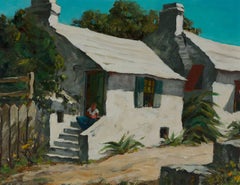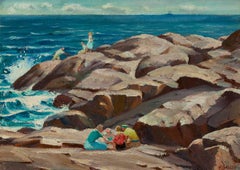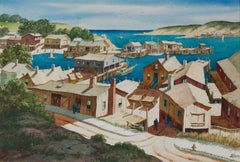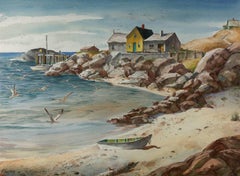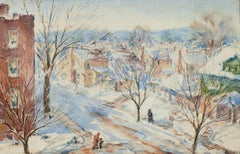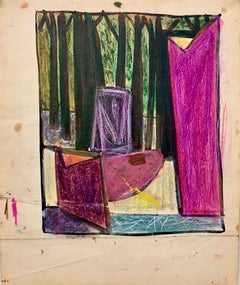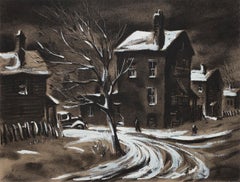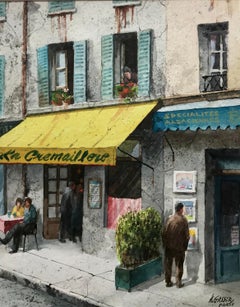American Modern Art
to
5
5
2
2
1
Overall Height
to
Overall Width
to
6
1
1
3
3
3
2
2
1
1
1
1
1
1
1
1
1
5
12
227
150
63
60
5
3
3
2
2
Style: American Modern
Artist: Henry Martin Gasser
Houses by the Lane, Bermuda
Located in New York, NY
Signed lower left: H. GASSER
Category
20th Century American Modern Art
Materials
Oil, Panel
On the Seashore
Located in New York, NY
Signed lower right: H. GASSER
Category
20th Century American Modern Art
Materials
Canvas, Oil
Gloucester Vista
Located in New York, NY
Signed lower right: H. GASSER; on verso: “Gloucester Vista” / HENRY GASSER / N.A.
Category
20th Century American Modern Art
Materials
Paper, Watercolor, Gouache
Sand, Sea, and Rocks
Located in New York, NY
Signed lower left: H. GASSER
Category
20th Century American Modern Art
Materials
Watercolor, Paper, Gouache
Newark Street Snow Scene in Sunlight with Figures
Located in New York, NY
Signed lower right: H. GASSER
Category
20th Century American Modern Art
Materials
Paper, Watercolor
Related Items
Christopher Street (abstract Greenwich Village cityscape)
Located in Wilton Manors, FL
De Hirsh Margules (1899-1965). Christopher Street, 1939. Watercolor on Arches wove paper. Signed and dated in pencil by artist lower margin. Sheet measures 15.5 x 20 inches. Window in matting measures 15 x 19 inches. Framed measurement: 23 x 30 inched. Bears fragment of original label affixed on verso. Incredibly vibrant and saturated color with no fading or toning of sheet.
Provenance: Babcock Galleries, NYC
Exhibited: The American Federation of Arts Traveling Exhibition.
From the facade of The Waverly at Christopher is depicted One Christopher Street, the 16-story Art Deco residential building erected in 1931. It is not a casual coincidence that the structure appears in this cityscape: 1 Christopher Street is the subject. The original intention of this project was to transform the neighborhood, bring a bit of affluence and make a bid to rival the Upper West Side. Margules, a sensitive aesthete, understood how a massive piece of architecture such as One changes a neighborhood. Sound, scale and focal points are forever altered. A pedestrian's sense of depth and distance becomes pronounced. All of these factors contribute to the intent behind this image. Tall buildings disrupt the human scale, change the skyline and carve up space. In this piece, negative space conforms to the man-made geometries. Clouds become gems fixed in settings.
De Hirsh Margules (1899–1965) was a Romanian-American "abstract realist" painter who crossed paths with many major American artistic and intellectual figures of the first half of the 20th century. Elaine de Kooning said that he was "[w]idely recognized as one of the most gifted and erudite watercolorists in the country". The New York Times critic Howard Devree stated in 1938 that "Margules uses color in a breath-taking manner. A keen observer, he eliminates scrupulously without distortion of his material." Devree later called Margules "one of our most daring experimentalists in the medium"
Margules was also a well-known participant in the bohemian culture of New York City's Greenwich Village, where he was widely known as the "Baron" of Greenwich Village.[1] The New York Times described him as "one of Greenwich Village's best-known personalities" and "one of the best known and most buoyant characters about Greenwich Village.
Early Life
De Hirsh Margules was born in 1899 in the Romanian city of Iași (also known as Iasse, Jassy, or Jasse). When Margules was 10 weeks old, his family immigrated to New York City. Both of his parents were active in the Yiddish theater, His father was Yekutiel "Edward" Margules, a "renowned Jewish actor-impresario and founder of the Yiddish stage." Margules' mother, Rosa, thirty-nine years younger than his father, was an actress in the Yiddish theater and later in vaudeville. Although Margules appeared as a child actor with the Adler Family[11] and Bertha Kalich, his sister, Annette Margules, somewhat dubiously continued in family theater and vaudeville tradition, creating the blackface role of the lightly-clad Tondelayo (a part later played on film Hedy Lamarr) in Earl Carroll's 1924 Broadway exoticist hit, White Cargo. Annette herself faced stereotyping as an exotic flower: writing about her publicist Charles Bouchert stated that "Romania produces a stormy, temperamental type of woman---a type admirably fitted to portray emotion." His brother Samuel became a noted magician who appeared under the name "Rami-Sami." Samuel later became a lawyer, representing magician Horace Goldin, among others. A family portrait including a young De Hirsh, a portrait of Rosa and Annette together, and individual photos of Rosa and Edward can be found on the Museum of the City of New York website.
At around age 9 or 10, Margules took art classes with the Boys Club on East Tenth Street, and his first taste of exhibition was at a student art show presented by the club. By age 11, he had won a city-wide prize (a box camera) at a children's art show presented by the department store Wanamakers.
As a young teenager, Margules was already displaying a characteristic kindness and loyalty. Upon hearing that two friends (one of them was author Alexander King), were in trouble for breaking a school microscope, the nearly broke Margules gave them five dollars to repair the microscope . Margules had to approach a wealthy man that Margules had once saved on the subway from a heart attack. Margules didn't reveal the source of the five dollars to King until twenty-five years later.
In his late teens, Margules studied for a couple of months in Pittsburgh with Edwin Randby, a follower of Western painter Frederic Remington. Thereafter he pursued a two-year course of studies in architecture, design and decoration at the New York Evening School of Art and Design, while working as a clerk during the day at Stern's Department Store. He was encouraged in these artistic pursuits by his neighbor, the painter Benno Greenstein (who later went by the name of Benjamin Benno).
Artistic career
In 1922, Margules began work as a police reporter for the City News Association of New York .Margules then considered himself something of an expert on art, and the painter Myron Lechay is said to have responded to some unsolicited analysis of his work with the remark "Since you seem to know so much about it, why don't you paint yourself?" This led to study with Lechay and a flurry of painting.
Margules' first show was in 1922 at Jane Heap's Little Review Gallery. Thereafter Margules began to participate in shows with a group including Stuart Davis, Jan Matulka, Buckminster Fuller (exhibiting depictions of his "Dymaxion house") in a gallery run by art-lover and restaurateur Romany Marie on the floor above her cafe.
Jane Heap, left, with Mina Loy and Ezra Pound
During the 1920s, Margules traveled outside of the country a number of times. In 1922, with the intent of reaching Bali, he took a job as a "'wiper on a tramp steamer where [he] played nursemaid to the engine." He reached Rotterdam before he turned back. He would return to Rotterdam shortly thereafter.
In 1927, Margules took a lengthy leave of absence from his day job as a police reporter in order to travel to Paris, where he "set up a studio in Montmartre's Place du Tertre, on the top floor of an almost deserted hotel, a shabby establishment, lacking both heat and running water." He studied at the Louvre and traveled to paint landscapes in provincial France and North Africa.
Margules also joined the "Noctambulist" movement and experimented with painting and showing his artwork in low light.Jonathan Cott wrote that:
the painter De Hirsch Margulies sat on the quays of the Seine and painted pictures in the dark. In fact, the first exhibition of these paintings, which could be seen only in a darkened room, took place in [ Walter Lowenfels'] Paris apartment.
Elaine de Kooning remarked that studying the works of the Noctambulists confirmed Margules' "direction toward the use of primary colors for perverse effects of heavy shadow."
It was also in Paris that Margules initially conceived his idea of "Time Painting", where a painting is divided into sectors, each representing a different time of day, with color choices meant to evoke that time of day.
In Paris, his social circle included Lowenfels, photographer Berenice Abbott, publisher Jane Heap, composer George Anthiel, sculptor Thelma Wood, painter André Favory, writer Norman Douglas, writer and editor George Davis, composer and writer Max Ewing, and writer Michael Fraenkel.
Upon his return to New York in 1929, Margules attended an exhibition of John Marin's paintings.
While at the exhibition, he "launched into an eloquent explanation of Marin to two nearby women", and was overheard by an impressed Alfred Stieglitz. The famous photographer and art promoter invited Margules to dine with his wife, the artist Georgia O'Keeffe, and his assistant, painter Emil Zoler. Stieglitz thereafter became a friend and mentor to Margules, becoming for him "what Socrates was to his friends."
Alfred Stieglitz
Stieglitz introduced Margules to John Marin, who quickly became the most important painterly influence upon Margules. Elaine de Kooning later noted that Margules was "indebted to Marin and through Marin to Cézanne for his initial conceptual approach - for his constructions of scenes with no negative elements, for skies that loom with the impact of mountains." Margules himself said that Marin was his "father and ... academy." The admiration was by no means unreciprocated: Marin said that Margules was "an art lover with abounding faith and sincerity, with much intelligence and quick seeing." Stieglitz also introduced Margules to many other artistic and intellectual figures in New York.
With the encouragement of Alfred Stieglitz, Margules in 1936 opened a two-room gallery at 43 West 8th Street called "Another Place." Over the following two years there were fourteen solo exhibitions by Margules and others, and the gallery was well-respected by the press. It was in this gallery that the painter James Lechay, Myron's brother, exhibited his first painting.
In 1936, Margules first saw recognition by major art museums when both the Museum of Modern Art and the Museum of Fine Arts, Boston purchased his works.
In 1942, Margules gave up working as a police reporter, and apparently dedicated himself thereafter solely to an artistic vocation.
"The Baron of Greenwich Village"[edit]
Margules made his mark not only as an artist, but also as an outsized personality known throughout Greenwich Village and beyond.
To local residents, Margules was known as the "Baron", after Baron Maurice de Hirsch, a prominent German Jewish philanthropist. Margules was easily recognizable by the beret he routinely wore over his long hair. Writer Charles Norman said that he "dressed with a flair for sloppiness."
He was said to "know everybody" in Greenwich Village, to the extent that when the novelist and poet Maxwell Bodenheim was murdered, Margules was the first one the police sought to identify the body. Margules' letters show him interacting with art world figures such as Sacha Kolin, John Marin and Alfred Stieglitz, as well as with prominent figures outside the art world such as polymath Buckminster Fuller and writer Henry Miller.
Most of his friends and acquaintances found Margules a generous and voluble man, given to broadly emotionally expressive gestures and acts of kindness and loyalty. In 1929, he exhibited an example of this loyalty and fellow-feeling when he appeared in court to fight what the wrongful commitment of his friend, writer and sculptor Alfred Dreyfuss, who appeared to have been a victim of an illicit attempt to block an inheritance.
The Greenwich Village chronicler Charles Norman described the bone-crushing hugs that Margules would routinely bestow on his friends and acquaintances, and speaks of the "persuasive theatricality" that Margules seemed to have inherited from his actor parents. Norman also wrote about Margules' routine acts of kindness, taking in homeless artists, constantly feeding his friends and providing the salvatory loan where needed. Norman also notes that Margules was blessed with a loud and good voice, and was apt to sing an operatic air without provocation.
The writer and television personality Alexander King said
I think the outstanding characteristics of my friend's personality are affirmation, emphasis, and overemphasis. He chooses to express himself predominantly in superlatives and the gestures which accompany his utterances are sometimes dangerous to life and limb. Of the bystanders, I mean.
King also spoke with affectionate amusement about Margules' pride in his cooking, speaking of how "if he should ever invite you to dinner, he may serve you a hamburger with onions, in his kitchen-living room, with such an air of gastronomic protocol, such mysterious hints and ogliing innuendoes, as if César Ritz and Brillat-Savarin had sneaked out, only a moment before, with his secret recipe in their pockets."
Margules was such a memorable New York personality that comic book writer Alvin Schwartz imagined him at the Sixth Avenue Cafeteria in a risible yet poignant debate with Clark Kent about whether Superman had the ability to stop Hitler.
Margules' entrenchment in the Greenwich Village milieu can be seen in a photograph from Fred McDarrah's "Beat Generation Album" of a January 13, 1961 writers' and poets' meeting to discuss "The Funeral of the Beat Generation", in Robert Cordier [fr]'s railroad flat at 85 Christopher Street. Among the people in the same photograph are Shel Silverstein...
Category
1930s American Modern Art
Materials
Watercolor, Rag Paper
1950s "Forest Through Window" MidCentury Abstract Gouache University of Paris
By Donald Stacy
Located in Arp, TX
Donald Stacy
"Forest Through the Window"
c.1950s
Oil pastel and gouache paint on paper
14" x 17" unframed
Unsigned
Came from artist's estate
Donald Stacy (1925-2011) New Jersey
Studied: Newark School of Fine Art
The Art Students League
Pratt Graphic Arts Center
University of Paris 1953-54
University of Aix-en-Provence 1954-55
Faculty: Art Department of the New School
Museum of Modern Art
School of Visual Arts
Stacy Studio Workshop
Exhibitions: Grand Central Moderns
George Wittenborn
The New School
Print Exhibitions, Chicago
University of Oklahoma
Honolulu Museum
Monclair Museum
Wisconsin State College
Louisiana Art...
Category
Mid-20th Century American Modern Art
Materials
Paper, Gouache, Oil Pastel
1950s "Mound Street" Mid Century Figurative Painting American Modernist
By Donald Stacy
Located in Arp, TX
Donald Stacy
"Mound Street"
c. 1950s
Gouache paint on paper
24" x 18'" unframed
Unsigned
Came from artist's estate
For sale is a striking black and white painting titled "Mound Stre...
Category
Mid-20th Century American Modern Art
Materials
Paper, Gouache
Modernist Cityscape
By Esther Rollick
Located in Buffalo, NY
An original modernist oil painting by American female artist Esther Rollick.
Category
1940s American Modern Art
Materials
Canvas, Oil
Trees at Bloom
Located in Los Angeles, CA
Trees at Bloom, 1939, oil on canvas, 32 x 24 inches, signed lower right
About the Painting
Trees at Bloom was painted when Clarence Holbrook Carter lived in Pittsburgh and served as an instructor in the Department of Painting and Design at the Carnegie Institute of Technology (now Carnegie-Mellon University), a position he held from 1938 through 1944. It depicts a thick forest at the base of distance hills just outside the city. During his tenure in Pittsburgh, Carter was deeply influenced by not only the industrial might of the steel mills and iron forges of the city, but also the beauty of the surrounding landscape. As Frank Anderson Trapp noted in his book on the artist, for Carter “the terrain itself had its own special vitality, with its craggy, wooded hills threaded with ravine and watercourses . . . . the signs of industrial blight that were unalleviated in some parts of the country were there relieved by the geological variety of the parent landscape, and by the irrepressible presence of its natural growth, which softened the whole.” Trapp continues, “in his scenes of rural situations, Carter had a special gift for rendering those elements convincingly.” With the profusion of flowering trees which diffuse the light and the red cardinals darting from one branch to another, Trees at Bloom portrays the “irrepressible presence of nature” that Trapp describes.
About the Artist
Together with Charles Burchfield, Clarence Holbrook Carter was Ohio’s premiere American Scene painter and later an innovative magic realist. The son of a no-nonsense public-school administrator, Carter was born in 1904 outside of Portsmouth, Ohio, a small town in the heart of the Ohio River...
Category
1930s American Modern Art
Materials
Canvas, Oil
Large Hudson River Figurative Modernist Landscape Oil Painting Edward Avedisian
Located in Surfside, FL
Edward Avedisian ( 1936-2007 )
Gouache or oil on paper, 3 guys around a car,
hand signed in paint lower left,
Measures 30"x 22.5"
Edward Avedisian (June 15, 1936, Lowell, Massachusetts – August 17, 2007, Philmont, New York) was an American abstract painter who came into prominence during the 1960s. His work was initially associated with Color field painting and in the late 1960s with Lyrical Abstraction and Abstract Expressionism.
He studied art at the School of the Museum of Fine Arts, Boston. By the late 1950s he moved to New York City. Between 1958 and 1963 Avedisian had six solo shows in New York. In 1958 he initially showed at the Hansa Gallery, then he had three shows at the Tibor de Nagy Gallery and in 1962 and 1963 at the Robert Elkon Gallery. He continued to show at the Robert Elkon Gallery almost every year until 1975.
During the 1960s his work was broadly visible in the contemporary art world. He joined the dynamic art scene in Greenwich Village, frequenting the Cedar Tavern on Tenth Street, associating with the critic Clement Greenberg, and joining a new generation of abstract artists, such as Darby Bannard, Kenneth Noland, Jules Olitski, and Larry Poons.
Avedisian was among the leading figures to emerge in the New York art world during the 1960s. An artist who mixed the hot colors of Pop Art with the cool, more analytical qualities of Color Field painting, he was instrumental in the exploration of new abstract methods to examine the primacy of optical experience.
One of his paintings was appeared on the cover of Artforum, in 1969, his work was included in the 1965 Op Art The Responsive Eye exhibition at the Museum of Modern Art and in four annuals at the Whitney Museum of American Art. His paintings were widely sought after by collectors and acquired by major museums in New York and elsewhere. He has been exhibited in prominent galleries, such as the Anita Shapolsky Gallery and the Berry Campbell Gallery in New York City. Edward Avedisian was known for his brightly colored, boldly composed canvases that combined Minimalism's rigor, Pop art exuberance and the saturated tones of Color Field painting.
Roberta Smith of the NYT writes of Avedesian: "Edward Avedisian helped establish the hotly colored, but emotionally cool, abstract painting that succeeded Abstract Expressionism in the early 1960s. This young luminary harnessed elements of minimalism, pop, and color field painting to create prominent works of epic proportions that energized the New York art scene of the time." In 1996 Avedisian showed his paintings from the 1960s at the Mitchell Algus Gallery, then in SoHo. His last show, dominated by recent landscapes, was in 2003 at the Algus gallery, now in Chelsea.
Selected Exhibitions:
Op Art: The Responsive Eye, at the Museum of Modern Art,
Whitney Museum’s Young America 1965
Expo 67, held in Montreal, Canada.
Six Painters (along with Darby Bannard, Dan Christensen, Ron Davis...
Category
20th Century American Modern Art
Materials
Oil, Gouache, Archival Paper
Large Modernist Abstract Expressionist Gouache Painting Bauhaus Weimar Artist
By Pawel Kontny
Located in Surfside, FL
Abstract watercolor or gouache composition bearing the influence of the earlier color-block compositions of Paul Klee.
Pawel August Kontny, (Polish-German-American artist) He was born in Laurahuette, Poland, in 1923, the son of a wealthy pastry shop owner. In 1939 he began studying architecture in Breslau where he was introduced to the European masters and to the work of some of the German Expressionists, soon afterward banned as "degenerate artists" and removed from museums throughout Germany by the Nazi regime. His studies were interrupted by World War II. Drafted into the German army, traveling in many countries as a soldier, he sketched various landscapes but in 1945, he was captured and held as a prisoner of war in Italy. After the war, he studied at the Union of Nuremberg Architects to help design buildings to replace ones destroyed in the war. He recorded his impressions of the local population and the landscapes through his watercolors and drawings. Pawel Kontny thereafter moved to Nuremberg, Germany, becoming a member of the Union of Nuremberg Architects and helping to rebuild the city's historic center. He soon decided to concentrate on his professional art career. He married Irmgard Laurer, a dancer with the Nuremberg Opera. Pavel Kontny 's career as an artist was launched with his participation in an all German exhibition, held at the Dusseldorf Museum in 1952. He held one-man shows in Germany, Switzerland and the United States. During his trip to the United States in 1960, Kontny became instantly enamored with Colorado, and decided to relocate to Cherry Hills with his wife and two children. He quickly established himself in the local art community, being affiliated for a time with Denver Art Galleries and Saks Galleries. His subject matter became the Southwest. During this time he received the Prestigious Gold Medal of the Art Academy of Rome. His extensive travel provided material for the paintings he did using his hallmark marble dust technique. he also worked equally in pastel, watercolor, charcoal and pencil-and-ink. in a style which merged abstraction and realist styles, influenced by Abstract Expressionist painting and South Western American landscapes. In the early 1960s he was one of only a few European-born professional artists in the state, a select group that included Herbert Bayer (1900-1985), a member of the prewar Bauhaus in Weimar and Dessau, Germany, and Roland Detre (1903-2001), a Hungarian modernist painter. As a Denver, Colorado resident, Pavel Kontny exhibited at galleries and museums throughout the United States, Germany and Japan. There, he was inspired by frequent trips to Native American pueblos in the Southwest, as well as by the study of the Plains Indians of Montana and Wyoming. Over the years Kontny had a number of students and generously helped young artist by hosting exhibitions at his Cherry Hills home. For many years he generously donated his paintings to support charitable causes in Denver. Influences during his European years included German pastelist C.O. Muller, German Informel painter Karl Dahmen and Swiss artist, Hans Erni. In the early 1950s his painting style showed the influence of the Die Brücke (The Bridge), a group of German expressionist artists formed in Dresden in 1905 who had a major impact on the evolution of modern art in the twentieth century in Germany. By the middle of the decade his style incorporated more referential abstraction and total abstraction, resulting in part from his study of Hans Hartung, a German artist based in Paris who exhibited his gestural abstract work in Germany. The American moon landing in 1969 inspired Paul Kontny...
Category
20th Century American Modern Art
Materials
Watercolor, Archival Paper
1950s "Two Trees" Mid Century Abstract Landscape Painting American Modern
By Donald Stacy
Located in Arp, TX
Donald Stacy
"Two Trees"
c.1950s
Gouache on paper
24" x 18" unframed $950
Unsigned
Came from artist's estate
*Custom framing available for additional char...
Category
Mid-20th Century American Modern Art
Materials
Paper, Gouache
Mid Century California Landscape Painting "Colored Roofs" Gouache on Paper
Located in Arp, TX
Thelma Corbin Moody (1908-1986)
Colored Roofs
c. 1960s
Gouache on Watercolor Paper
22" x 15", Unframed
This piece is unsigned and came from a large...
Category
Mid-20th Century American Modern Art
Materials
Paper, Gouache
San Francisco Cable Car WPA Artist Adolf Dehn Modernist Art Gouache Oil Painting
By Adolf Dehn
Located in Surfside, FL
ADOLF ARTHUR DEHN (American, 1895-1969)
San Francisco Bay Area street scene, with Trolley, Streetcar, Cable Car with bay and Alcatraz Island in background.
Hand signed LRC.
Sight 19" x 15", overall 23" x 19".
Adolf Dehn (November 22, 1895 – May 19, 1968) was an American artist known mainly as a lithographer. Throughout his artistic career, he participated in and helped define some important movements in American art, including regionalism, social realism, and caricature. A two-time recipient of the Guggenheim Fellowship, he was known for both his technical skills and his high-spirited, droll depictions of human foibles.
Adolph Dehn was born in 1895 in Waterville, Minnesota. He began creating artwork at the age of six, and by the time of his death had created nearly 650 images.
Dehn went to the Minneapolis School of Art (known today as the Minneapolis College of Art and Design), where he met and became a close friend of Wanda Gag. In 1917 he and Gág were two of only a dozen students in the country to earn a scholarship to the Art Students League of New York. He was drafted to serve in World War I in 1918, but declared himself a conscientious objector and spent four months in a guardhouse detention camp in Spartanburg, SC and then worked for eight months as a painting teacher at an arm rehabilitation hospital in Asheville, NC. Later, Dehn returned to the Art Students League for another year of study and created his first lithograph, The Harvest.
In 1921 Dehn's lithographs were featured in his first exhibition at Weyhe Gallery in New York City. From 1920 to 1921 in Manhattan, he was connected to New York's politically left-leaning activists. In 1921, he went to Europe. In Paris and Vienna he belonged to a group of expatriate intellectuals and artists, including Andrée Ruellan, Gertrude Stein, and ee cummings...
Category
1930s American Modern Art
Materials
Oil, Gouache
Ventian Courtyard
By Enid Smiley
Located in Buffalo, NY
An original oil on canvas by listed New York female artist Enid Smiley.
Category
1950s American Modern Art
Materials
Canvas, Oil
Six O'Clock
Located in Los Angeles, CA
Six O-Clock, c. 1942, oil on canvas, 30 x 20 inches, signed and titled several times verso of frame and stretcher (perhaps by another hand), marked “Rehn” several times on frame (for the Frank K. M. Rehn Galleries in New York City, who represented Craig at the time); Exhibited: 1) 18th Biennial Exhibition of Contemporary American Oil Paintings from March 21 to May 2, 1943 at The Corcoran Gallery of Art in Washington, D.C. #87, original price $450 (per catalog) (exhibition label verso), 2) Craig’s one-man show at the Frank K. M. Rehn Galleries, New York City, from October 26 to November 14, 1942, #10 (original price listed as $350); and 3) Exhibition of thirty paintings sponsored by the Harrisburg Art Association at the State Museum of Pennsylvania in Harrisburg in March, 1944 (concerning this exhibit, Penelope Redd of The Evening News (Harrisburg, Pennsylvania) wrote: “Other paintings that have overtones of superrealism inherent in the subjects include Tom Craig’s California nocturne, ‘Six O’Clock,’ two figures moving through the twilight . . . .” March 6, 1944, p. 13); another label verso from The Museum of Art of Toledo (Ohio): original frame: Provenance includes George Stern Gallery, Los Angeles, CA
About the Painting
Long before Chris Burden’s iconic installation outside of the Los Angeles County Museum of Art, Urban Light, another artist, Tom Craig, made Southern California streetlights the subject of one of his early 1940s paintings. Consisting of dozens of recycled streetlights from the 1920s and 1930s forming a classical colonnade at the museum’s entrance, Burden’s Urban Light has become a symbol of Los Angeles. For Burden, the streetlights represent what constitutes an advanced society, something “safe after dark and beautiful to behold.” It seems that Craig is playing on the same theme in Six O-Clock. Although we see two hunched figures trudging along the sidewalk at the end of a long day, the real stars of this painting are the streetlights which brighten the twilight and silhouette another iconic symbol of Los Angeles, the palm trees in the distance. Mountains in the background and the distant view of a suburban neighborhood join the streetlights and palm trees as classic subject matter for a California Scene painting, but Craig gives us a twist by depicting the scene not as a sun-drenched natural expanse. Rather, Craig uses thin layers of oil paint, mimicking the watercolor technique for which he is most famous, to show us the twinkling beauty of manmade light and the safety it affords. Although Southern California is a land of natural wonders, the interventions of humanity are already everywhere in Los Angeles and as one critic noted, the resulting painting has an air of “superrealism.”
About the Artist
Thomas Theodore Craig was a well-known fixture in the Southern California art scene. He was born in Upland California. Craig graduated with a degree in botany from Pomona College and studied painting at Pamona and the Chouinard Art School with Stanton MacDonald-Wright and Barse Miller among others. He became close friends with fellow artist Milford Zornes...
Category
1940s American Modern Art
Materials
Canvas, Oil
Previously Available Items
Winter Night
Located in New York, NY
Signed lower left: H. GASSER,
Category
20th Century American Modern Art
Materials
Charcoal, Gouache
“La Crémaillère, Paris”
Located in Southampton, NY
Watercolor and gouache on paper of “La Crémaillère” located in Montmartre, Paris. Signed lower right, H. Gasser, Paris. 20th century. Circa 1950-1960. Condition: Excellent. In Ar...
Category
20th Century American Modern Art
Materials
Paper, Gouache, Watercolor
House on the Hill
Located in New York, NY
Signed upper left: H. GASSER
Category
20th Century American Modern Art
Materials
Paper, Watercolor, Gouache
Paris Spring (Le Printemps aux Parisien)
Located in Saint Augustine, FL
An original signed watercolor / gouache on paper by American artist Henry Martin Gasser (1909-1981) titled "Paris Spring (Le Printemps aux Parisien)", c. 1960. Hand signed ...
Category
1960s American Modern Art
Materials
Watercolor, Gouache
The Boathouse
Located in Saint Augustine, FL
An original signed watercolor / gouache on paper by American artist Henry Martin Gasser (1909-1981) titled "The Boathouse", c. 1960. Hand signed by Gasser lower right. This artwork i...
Category
1960s American Modern Art
Materials
Watercolor, Gouache
Harbor in Bermuda
Located in New York, NY
Signed lower right: H. GASSER; on verso: H. GASSER
Category
20th Century American Modern Art
Materials
Oil, Panel, Canvas
American Modern art for sale on 1stDibs.
Find a wide variety of authentic American Modern art available for sale on 1stDibs. Works in this style were very popular during the 21st Century and Contemporary, but contemporary artists have continued to produce works inspired by this movement. If you’re looking to add art created in this style to introduce contrast in an otherwise neutral space in your home, the works available on 1stDibs include elements of blue, orange, purple, red and other colors. Many Pop art paintings were created by popular artists on 1stDibs, including Slim Aarons, Destro, Howard Schatz, and John Taylor Arms. Frequently made by artists working with Paint, and Oil Paint and other materials, all of these pieces for sale are unique and have attracted attention over the years. Not every interior allows for large American Modern art, so small editions measuring 0.25 inches across are also available.
Recently Viewed
View AllMore Ways To Browse
Wall Fresco
19th Century Spanish Paintings
Greek Woman
Oil Painting Man 19th
Native American Gold
Cut Paper Wall Art
Antique Painting Auction
Antique Painting Auctions
Japanese Painting Gold Leaf
Gold Leaf Painting Japan
Lady Just
Sea Life Gold
Canvas Midcentury Print
Costa Vintage
Russian Vintage Fashion
Coat Mans
Head Of Man Sculpture
Sculpture 1942
